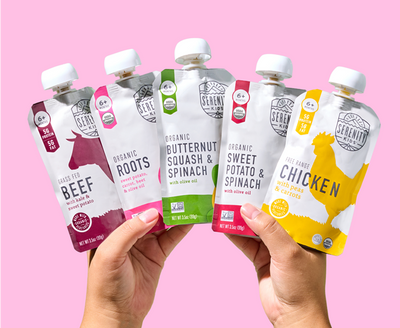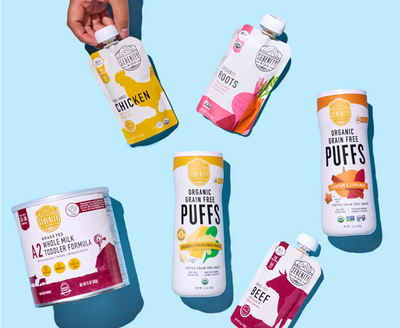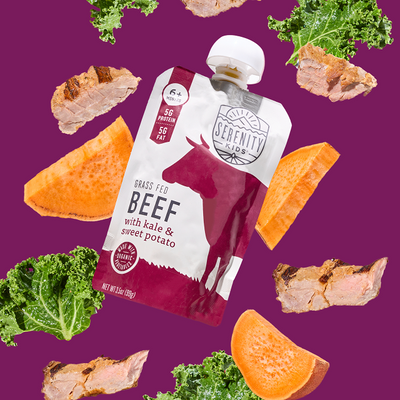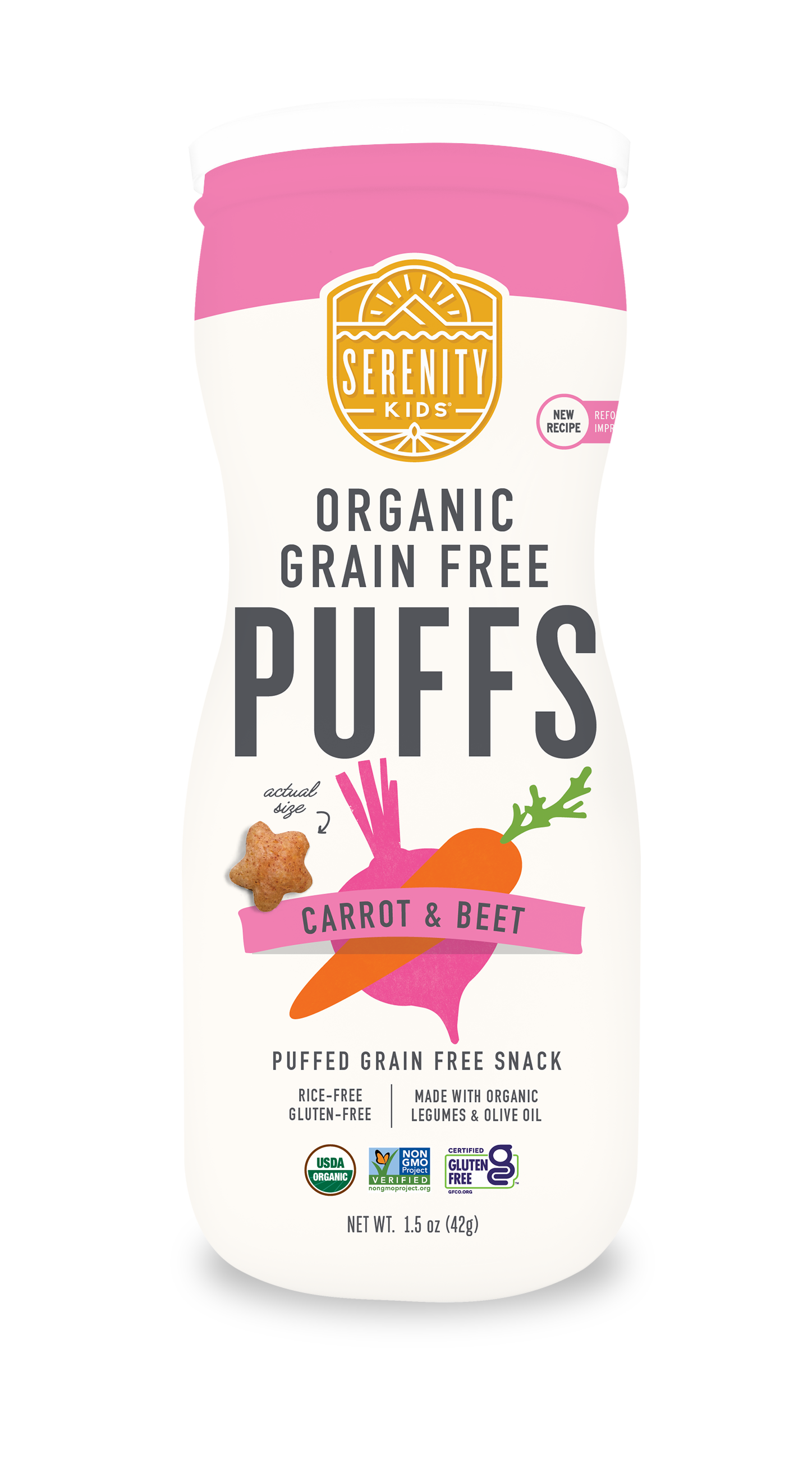At Serenity Kids, we’re on a mission to help parents provide the best nutrition for their little ones. We understand the weight of responsibility that comes with nourishing a child, and we're here to lend a hand as you navigate the world of baby foods. Part of that is deciphering what you see on baby food labels. One common question we hear from parents is what the various “stages” mean. We're getting into this classification below, and we'll dive specifically into “stage 3” baby food.
Stage 3 Baby Food: What the heck does this mean?
Baby food designed for older babies between the ages of nine and 12 months is often labeled as “Stage 3 baby food”. Here at Serenity Kids, we have chosen not to use these stage classifications because they can be confusing and aren’t super meaningful. Instead, we focus on making nutrient-dense, organic, GMO-free, and delicious pureed foods for a wide range of ages. “Stage 3 baby food” is designed to offer more texture and variety in order to encourage self-feeding and aid in the development of motor skills. Stage 3 baby food often contains more finely pureed fruits and vegetables while also providing an introduction to soft chunks and pieces like vegetable sticks and mashed sweet potato. This type of food helps babies get used to different tastes and textures as they move towards more solid foods.
Know that you do not need to follow the stage guidelines when feeding your baby, but here is a guide to what they mean:
Stage 1: 6 months
Phase 1 baby foods are single-ingredient, completely pureéd foods that are introduced to babies at around 6 months old.
Stage 2: 7-8 months
The next stage introduces multiple ingredients in thicker mashed or strained food for your child’s diet, including meats. These textures can help babies learn how to move solids from the front of their mouth to the back for swallowing.
Stage 3: 9 to 12 months
During this period, babies continue exploring different flavors and textures while starting on foods with small chunks, and some finger foods, which helps them develop chewing skills.
Stage 4: After 12 Months
This final stage usually involves small pieces of regular table food, fostering independent eating habits in toddlers who are ready for it. The journey through each baby food stage might seem daunting but it is an exciting adventure worth embracing.
Determining Baby’s Age for Stage 3 Foods
Preparing babies to transition from breast milk or formula to solid foods can sometimes be daunting. The important thing is to regularly introduce them to a variety of flavors and textures that will help them grow and develop.
When to start stage 3 baby food
Stage 3 baby food is intended for babies who have already tried some smoother and single ingredient purees, like carrot baby puree, around 9 months old. However, a baby eating solids at any age can also enjoy these foods.
Signs a baby is ready for stage 3 food
Stage 3 baby food is typically a combination of puree with soft-cooked chunks of food. A baby can be ready for this type of food at any time. However if they show particular interest in more sophisticated flavors or textures at mealtime or they have enjoyed table foods or finger food, they are probably ready for stage 3 baby food.
Stage 3 Nutrition: Baby’s Nutritional Requirements
When a baby starts solids at around 6 months old, their baby food should provide the nutrition that they need to grow and develop. This includes a variety of proteins, fats, carbohydrates, vitamins, and minerals.
Protein sources can include poultry, beef, fish, and eggs. Fat can come from olives, coconut, and avocado, plus their oils. In addition, babies can get healthy fats from properly prepared nuts and seeds (for example, chia or flax seeds in a smoothie, or hemp seeds sprinkled on pureed food). Carbohydrates can come from lower-sugar fruits and cooked vegetables.
Vitamins A, B6, B12, C, D, and E and minerals like iron, zinc, and calcium are especially important for bone growth, metabolism, energy, immune health, and more. Babies should also consume essential fatty acids like omega-3s to support brain development. A diet rich in healthy whole foods like meat, fish, vegetables, and low sugar fruits can provide many of these vitamins and minerals. Remember, little ones are always observing you, including at the table. So modeling healthy eating habits is invaluable to raising healthy eaters.
Feeding Your Baby: What Foods to Start With
If feeding your baby feels overwhelming, here are a few easy ideas to start with:
1. Serenity Kids Pouches
The ultimate in healthy convenience, our pouches are full of healthy protein and fat, plus plenty of flavor thanks to ingredients like herbs, spices, and bone broth.
2. Serenity Kids Smoothies
For a fun flavor twist from our savory pouches, try one of our smoothies made with grass-fed collagen, coconut milk, and root veggies and berries.
3. Well-cooked vegetables
Cook veggies until they are soft enough to smush with your finger. Soft foods present less of a choking risk. We like to cook veggies in bone broth, coconut oil, ghee, olive oil, or bone marrow. Any veggie is great, so try a variety, like cruciferous veggies (broccoli and cauliflower) or root veggies (sweet potatoes, beets, or carrots).
5. Soft cooked meat or fish
Proteins like ground beef, shredded meat or poultry, and flaked salmon provide good texture and a ton of nutrient density.
6. Scrambled eggs
Eggs are full of healthy protein and fat, plus great B vitamins and choline. Scrambled eggs are soft and easy for little ones to eat at any age.
Foods to Avoid
The foods to avoid in your baby's diet at this stage aren't much different from any other stage. Here are a few things to keep an eye out for:
1. Sugar
The American Academy of Pediatrics recommends that you avoid serving sweetened foods or drinks with added sugar to children under 2 years of age.
2. Whole nuts
Whole nuts like whole peanuts are a choking risk for babies learning to eat. They are just small and hard enough to easily get lodged in their throats. Chop nuts finely or use a thin layer of nut butter on other foods for your little one.
3. Honey
Babies under one year of age should not be given honey as it can contain Clostridium, a bacteria that causes infant botulism.
4. Round or circular foods
Foods like whole cherry tomatoes, whole grapes, hot dogs, cooked pasta, and whole blueberries are a choking risk. They should always be cut in half or into small pieces.
Example Stage 3 Baby Food Recipes
Stage 3 baby foods don't have to be complicated. You can always just spend less time pureeing the same types of foods that you prepared previously, if you followed stage 1 or stage 2 baby food recipes. You can also add in some herbs and spices if you haven't yet introduced them to your little one. Here are some of our favorite recipes:
1. Beef and ginger patties
Use a Serenity Kids pouch as a shortcut in this great meal prep recipe.
3. Garlic Cauliflower Potato Mash
This is a great dish for both adults and little ones that is full of veggies and healthy fats.
4. Serenity’s Dairy-Free Bacon Onion Dip
If your little one loves savory and sophisticated flavors, they'll love this dip that is a staple on Serenity's entertaining menu.
5. Thanksgiving Baby Food
This one is full of fall flavors. Feel free to leave it a little chunky by not pureeing it until smooth.
5 Best Tips for Feeding Stage 3 Baby Food
Feeding stage 3 foods baby food isn't complicated. Here are a few tips:
1. Add a variety of textures and flavors for a more diverse range of tastes
Diverse flavors and textures help provide a great sensory experience and also help to expand your child's palate. Continue to try new foods, and retry foods that they may have rejected the first time (or the first few times!).
2. Let your child take the lead
No matter what age your child is, or what stage (or stages) you might choose to feed them, feeding should always be a no pressure experience. You provide the nutritious options, and they decide what and how much to eat.
3. Ensure your little one's food is easy to chew
Set your little one up for success by preparing their food properly, making it safe and easy to chew.
4. Pay attention to your baby's signals for hunger and fullness
Babies won't always be in the mood to eat, and that's ok. Pay attention to their signals for hunger and fullness so you know when to offer food and when to take a pause:
- Signs of hunger: reaches for or points to food, opens their mouth when offered a spoon or food, or makes noise or gets excited at the sight of food
- Signs of fullness: pushes food away, closes their mouth when food is offered, or turns their head away from food
5. Until age 1, continue supplementing meals with breastmilk or formula for your little one
Remember that until age one, breastmilk or formula is still a key component of their nutrition. Even if your little one loves to eat solid food, it is important to still offer breastmilk or formula.
Takeaway
From the never-ending quest to find the perfect balance of flavors to the desire to introduce wholesome ingredients, we know that feeding a little one can feel like a lot. We hope you stay with us on the journey as we share practical more tips, nourishing recipes, and heartfelt encouragement. Consider signing up for our baby food subscription to make feeding your little one even easier. To know what experts think about our baby food, this Forbes Serenity Kids review could provide helpful insights.















































